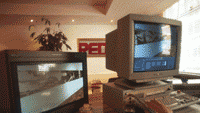Troubleshooting digital video to ensure signal quality
The traditional video equipment and infrastructure associated with video post-production is slowly becoming a thing of the past. Today, fewer post-production facilities are investing in video infrastructures. Instead, many facilities are giving computer workstations an increasing role in post-production, and many are also improving their IT networks. A recent survey indicates that the largest growth in facility investments for 2004 will be in production servers and computer workstations. It also shows that the number of facilities investing in production servers this year is nearly twice that of last year.

To help save time and increase productivity, post-production facilities are looking for digital technologies that can eliminate time-consuming tasks such as I/O, archiving and rendering from the creative systems, allowing them to be processed in parallel. British post-production facility Red uses Discreet’s backdraft media management and I/O system to load and unload its inferno and fire suites without tying them up.
In fact, video post-production infrastructure is undergoing a highly accelerated transition from video-signal routing to data routing, and this is having a profound impact on everything from facility workflow to equipment expenditure and staffing. Simon Leppington, technical director at Red, a British post-production facility with expertise in broadcast graphics, commercials and digital film, says that the proportion of his company’s equipment budget that goes into IT infrastructure is massive compared to a few years ago. The company’s investment in video infrastructures is relatively minor and mainly for maintenance.
Networking and storage
Red’s equipment budget is typical of many facilities that are building digital workflows capable of scaling efficiently. The budget calls for increased storage capacity, high-performance networking solutions (GSN, Gigabit and 10-Gigabit Ethernet), background-rendering capabilities and asset management. Investing in data storage is also important for managing workflow between systems, reducing redundancies and data conversions, and facilitating greater sharing and collaboration.
There are three basic types of storage methods: direct-attached storage (DAS), including switchable storage; network-attached storage (NAS); and storage-area networks (SANs). The highest-performing DAS solutions tend to be vendor-optimized for the system to which they are attached. The highest-performing NAS and SAN solutions are open, non-vendor-specific solutions such as those offered by SGI and IBM that can scale to multiple HD and 2K streams and can host a wide range of different operating systems.
Big, cheap hard drives
The professional video industry's #1 source for news, trends and product and tech information. Sign up below.
Red is also one of several facilities using IDE, SCSI or even Fibre Channel disk drives as more efficient archiving media, capable of handling the huge range of multiformat data required to complete contemporary projects. Modern production data is no longer confined to videotape but includes a multitude of data types such as 3D models and rendered elements, Photoshop and Illustrator files, and project metadata from NLEs and visual effects systems. The cost savings both in time and efficiency of storage archiving can be significant and will only get better with time. Even today, the cost of purchasing, installing and running an archiving workflow to 120GB external drives capable of holding more than 60 minutes of RGB PAL can be less than that for a comparable D1 system.
Talent and tools
Competition in post-production is fierce. Successful facilities tend to be those that invest in talented staff and creative technologies to offer the best performance across the widest range of creative projects. Investments that limit creative capabilities or reduce overall performance for the sake of accelerating a few basic tasks can fail to deliver the flexibility required to compete effectively in the long-term.
Chris Mortimer, head of visual effects and inferno artist at Red, says that in a creative industry, you have to keep up with the creativity of your clients. Key to any post-production facility’s success is a combination of the best and highest-performing creative talent and tools. Ultimately, if the creative talent and capabilities are not there, it will not matter how efficient the workflow or how fast the system, there will be little added value to the resulting production. One visual-effects veteran once said that you have to figure out the art first, and then you figure out how to do it.
Great expectations
Post-production clients have ever-increasing standards. Every project successfully completed just ratchets expectations higher. No matter how difficult the original creative task, once a client has seen it done, he knows it can be done and wants to move on to the next level. This results in a relentless escalation in production complexity as the creative workload per project continues to increase. As digital technology has made more possible, it is increasingly used to do more.
Five years ago, adding a photorealistic CG effect such as an animated dinosaur was extremely costly to produce. Today, facilities can add such effects for a fraction of the cost. The net result is an increasing expectation of what can be done, resulting in intense pressure on broadcasters and facilities to do more on each project. To accomplish this, they must allow their artists, editors and animators to collaborate effectively in a networked digital environment.
Time and productivity
A post-production facility’s success depends on being able to offer the best creative services cost-effectively. Time is money, and it is a key cost factor to be considered. Being able to maintain high levels of productivity throughout the project and not just on isolated tasks is critical to the long-term success of any company.
To help save time and increase productivity, post-production facilities are looking for digital technologies that can eliminate time-consuming tasks such as I/O, archiving and rendering from the creative systems, allowing them to be processed in parallel. None of these tasks require the supervision of the artist or editor. Instead, facilities such as Red employ a new breed of “media-operators” to digitize media, archive projects, transfer files, and manage the facility’s content and metadata. These data-savvy “tape-ops” people manage the throughput of the facility and ensure effective collaboration. To do so, they use fast networks and asset- and media-management software applications. Red’s Mortimer says that the facility uses Discreet’s backdraft media management and I/O system to load and unload inferno and fire suites without tying them up. This allows him to move on to the next job immediately and spend more time doing what he wants to do: creating good pictures.
Table 1. A comparison of the RGB and YcbCr formats and their associated color capacities. Click here to see an enlarged diagram.
From YCbCr to RGB
Guaranteeing image quality is a major concern. Clients are always quality-conscious. Given the choice, few intrinsically desire a lower quality product, even if their budgets may be somewhat limited. Today, content arrives in an ever-increasing range of formats: DV, BetaSP, DigiBeta, D5, HDCAM, DVCPRO and, of course, celluloid film (2K, 4K). Facilities must output the final product in an even wider array of formats. In between ingest and output, the content almost certainly must be processed digitally by a computer. To do this effectively and at the highest possible quality, modern post-production systems are designed to store content in 10-bit or higher RGB data formats, although some legacy video systems still use compressed YUV formats due to performance limitations. The next few years are likely to see a widespread adoption of 10-bit RGB workflows as well as adoption of standardized formats such as DPX.
Film, video and computer-generated imagery (CGI) all start with RGB intensity components, which is the native color representation of video cameras, computer monitors, video monitors and television. However, for more than a decade, video systems, with the exception of a few high-end systems, have used sub-sampled YCbCr 4:2:2 formats to reduce data capacity and make more efficient use of the available bandwidth. This sub-sampling causes an unrecoverable loss of half the color detail, significantly reducing image quality and making it more difficult to do any color correction or graphics and visual effects work such as pulling blue-screen or green-screen mattes. Table 1 compares the RGB and YCbCr formats and their associated color capacities. Wherever possible, facilities should acquire RGB 4:4:4 directly from telecine, digital cameras (such as the Thomson Grass Valley WorldCam) or through RGB video formats such as HDCAM-SR. Facilities should convert YCbCr sources destined for computer processing to RGB immediately on ingest and maintain this color space to avoid repeated conversions back and forth between RGB and 4:2:2. Conversions subsequent to the first are liable to accumulate rounding errors and are liable to accumulate filtering artifacts such as aliasing.
Red’s Leppington says that maintaining image quality is about keeping all the data to the last minute and not throwing it out at the start. He adds that if a client has shot on film, he’d prefer to transfer and grade at 2K — keeping as many of the advantages of the high-resolution production format instead of discarding them immediately upon ingest.
Keeping up with the Joneses
In the ever-changing post-production environment, maintaining a competitive edge is crucial for survival. There are several things you can do to stay ahead in the digital production game:
- Invest more in computer workstations and less in traditional VTR-based systems.
- Invest in high-performance IT-based infrastructures (GSN, Gigabit and 10-Gigabit Ethernet).
- Invest in high-capacity digital storage solutions (DAS, NAS, SAN).
- Use big, cheap hard drives for archiving.
- Hire the most creative talent (artists, editors and animators) you can find.
- Allow your talent to collaborate effectively in a networked digital environment.
- Use “media operators” and asset- and media-management software applications to digitize media, archive projects, transfer files, and manage the facility’s content and metadata more effectively.
- Wherever possible, acquire RGB (4:4:4) directly from telecine, digital cameras or through RGB video formats.
- Convert YCbCr sources destined for computer processing to RGB immediately on ingest and maintain this color space to avoid repeated conversions back and forth between 4:4:4 and 4:2:2.
Maurice Patel is systems product marketing manager for Discreet.
